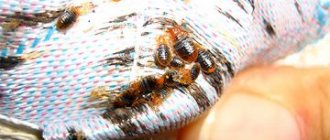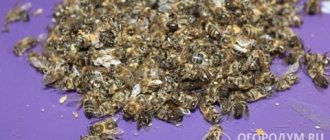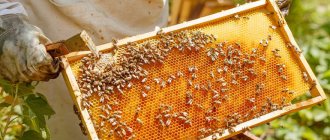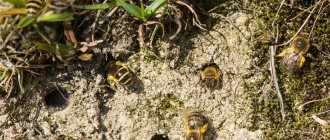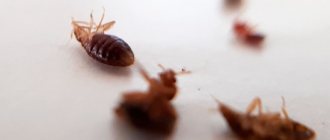At the height of the summer period, the vital processes of various insects are activated. The bees belonging to them begin to actively collect nectar from honey plants. Despite their peaceful nature, if their life is threatened or if they choose a secluded place in the garden as a shelter, aggressive behavior towards humans may appear. Therefore, you should know what ways you can scare away uninvited guests.
What are bees afraid of? There are many ways to kill bees on your property. Methods vary from growing herbs beneficial to humans to using specialized toxic substances. The choice should be based on the individual capabilities of the gardener.
How can bees interfere?
They can be dangerous if:
- Someone in the family is allergic to their bite. Then their presence can become a threat to life.
- There are children in the house. Especially up to 5-8 years old. Bees usually don't attack. However, a child can provoke them with his behavior. The result is crying, itching, swelling and fever.
- Feasts and parties are often held in the garden. Bees do not like the smells of alcohol and tobacco smoke, as well as perfume, garlic and onions. They become more aggressive and can sting.
Earth bees can choose one of the beds and build their nest there. They usually do not bite and are not harmful to crops.
There are also carpenter species. They damage walls and wooden buildings, gnawing holes in them to lay larvae. They usually don't bite either.
Harm and benefit
Before poisoning bees, scaring them away or moving them to another place, it is worth assessing the benefits and damage that insects can cause. Both wild and domestic honey bees are the main pollinators of garden and vegetable crops. Their presence is a guarantee of a good harvest.
However, too many insects or poor placement of the nest, such as inside a wooden wall, pose a danger. Domestic bees rarely attack first; wild bees are much more aggressive and their poison is stronger. If a swarm lives right in a window frame or in a wall, such a neighborhood poses a threat.
There are wild bees in the area
The best way to get rid of a wild swarm is to ask a beekeeper.
However, you can get rid of it yourself. The main thing is to wear a protective suit:
- light in color and made of dense material;
- with thick gloves (you can use rubber ones);
- with a mosquito net to protect your head (you can wear an additional hat under it, in case the fabric gets bitten).
After that you can start. We get rid of flying enemies using one of these methods:
Move bees to another location
You can take pity on the swarm and move it to another area.
It is better to get rid of it in the evening, when the insects have just returned from honey collection. They need to be smoked with a smoker.
Then the clumsy and “loaded” with honey insects (therefore not biting) will run to escape. All that remains is to get rid of the honeycombs by moving them away.
Destroy their home
The queen bee always remains in the nest. If you destroy it and the larvae, the rest of the family will die.
Here's how to do it:
- Using smoke or fire. This option is suitable if the nest is in a fireplace or chimney.
- Boiling water. Or liquids like diesel/gasoline. It is convenient if the bee houses are located in the ground or hollow.
- Insect repellents. They are called insecticides. “Dust” for cockroaches will do.
When to attack: If the nest is in an easily accessible place - on a clear sunny morning, when the insects go to collect honey. If in a hard-to-reach place, late in the evening, when the entire bee colony will gather in one place and will not be able to attack from the air.
Vacuum
Insects need to be fumigated with a smoker and sucked into a vacuum cleaner. It is better to do this in the evening, when the entire swarm is assembled.
Interesting!
The collected insects can be ground and fertilized with them in the garden.
Bees are calmest in warm weather, and more aggressive in cold weather.
It's easier to get rid of them in winter. You need to let the cold into their home, and the insects will die.
By the way, using traps against honey-bearing species is ineffective. A standard hive contains several thousand insects and new ones are added weekly. You won't be able to catch everyone.
Methods of disposal
The methods listed below will tell you how to deal with annoying neighbor bees.
Before going to extreme measures, be sure to make sure that you have done everything necessary:
- If your neighbors have bees that sting and you don't know what to do, talk to the owner.
- Get rid of bees on your property using folk remedies.
- Use of insect repellents.
What to do, how to act if your neighbor has honey miners who don’t give him peace? Of course, the use of insect repellents. To understand how to protect yourself from your neighbor’s aggressive insects by using repellers, study the principle of operation:
- Lamps. They attract neighboring insects using ultraviolet light and shock them.
- Ultrasonic devices . The waves they emit scare away and kill uninvited guests.
- Special lamps . Covers an area of 30-45 meters. They have a long period of use - 4-5 years.
- Poison . Set up some traps. Pour a sweet liquid into it, add salt and toxic substances. If you do not want to come into contact with poison, contact the sanitary and epidemiological station. Disinsection service employees will quickly destroy the annoying inhabitants of the apiary.
How to destroy dangerous bees? Use traps, drinking bowls, which you fill with sweet bait - compote, jelly, juice. Add toxic substances and salt to the liquid.
Traditional methods of disposal
There are several options for using folk remedies to combat hive inhabitants.
Method 1 . Using traps. To figure out how to destroy dangerous bees with traps, you need to learn how to make them. Prepare insect traps from plastic bottles. Pour a sweet liquid into the container - syrup, compote, which will attract honey miners. They will not be able to get out of the trap.
Method 2 . Find unnecessary rags. Moisten it with a solution of essential oils, peppermint decoction, and vinegar solution (10-15 ml of vinegar are diluted with 1.5-2 liters of water). Hang the rags on the dividing fence of the areas.
Method 3 . Build a fire. The smell of smoke scares away the inhabitants of the hives. Throw dry catnip branches into the fire. Light a fire away from trees and wooden buildings.
Method 4 . Play a recording of bird sounds. Download a recording of birdsong from the Internet. Play as often as possible.
Method 5 . Hang bags filled with mothballs to protect the area.
How to understand where bees come from
If there is an apiary nearby, insects are likely to fly from there. Most likely, the site attracts them with flowering plants and water, which is often left in tanks.
If there is a wild swarm, its noise will often be heard in the garden. Wild bees are attracted to dark and warm places. So, first of all, you should look for them under the roof, in pipes and in the ground.
Using the magic canvas.
Such canvases appeared on sale relatively recently. Used to reduce bee aggression when collecting honey. In small apiaries they can replace bee removers. Of course, they are not suitable for large and industrial apiaries.
They are a cotton fabric that needs to be impregnated with a special essential oil. It contains special components. All the “magic” is based on them.
It's quite simple to use.
The fabric is taken out of the packaging and unfolded.
The drug is applied pointwise to it and distributed evenly over the entire surface.
During the inspection of the bee colony, the main canvas or film is gradually rolled up and replaced with a “magic” one.
When selecting frames with honey, it is recommended to leave the canvas for 20-30 minutes. The bee will gradually come down, and you can calmly select the frames.
Also, such a canvas can be used to cover already selected cases of honey to prevent attacks by bees.
Try to solve the problem peacefully
Peaceful methods of disposal are the best option. You can try to negotiate with your neighbor so that he does the following:
- I changed the bees to another variety if these are too aggressive and bite. Some bee breeds are calm and peaceful, so they won’t cause much trouble to others.
- Replaced the fence. For a continuous fence with a higher height - from 2 meters.
- I planted more trees and shrubs on my property. Ideally, fast-growing and frequent flowering.
- Moved the hives. If the apiary is 30-40 meters from houses, the bees will not bother people.
- Replaced the queen in a bee colony. The behavior of bees often depends on the female. Sometimes when replacing it, insects become calmer.
Worth knowing!
If you choose the area for your apiary wisely, you can significantly increase its productivity and the amount of honey. This can be cited as an argument.
To increase the chances of your neighbor's consent, you can offer to help him move the hives.
Discussing the problem with neighbors and finding a joint solution
Unfortunately, most novice beekeepers do not realize that placing an apiary requires installing high three-meter fences around the territory. This allows insects to gain altitude in flight and, bypassing neighboring areas, go towards flowering fields.
This is why it is important to discuss the problem of nuisance bees with your neighbor and try to reach a compromise. To make the conversation more convincing, you should warn that if the problem is not solved, then bait will be placed around the area. In most cases, such an argument allows you to quickly solve the problem.
Discuss the problem with your neighbors
How to get rid of bees legally
Currently, such laws are only being developed, so what is stated below is of a recommendatory nature.
Here's how to get rid of your neighbor's bees if your neighbor refuses to resolve the problem peacefully:
- You need to go to the doctor and have the bite certified if there is one. The doctor will issue a confirmation certificate.
- Measure the height of your neighbor's fence. According to the standards, it must be more than 2 meters. An exception is if the apiary is located at a height of 2 meters.
- Measure the distance from your site to the hives. The latter should be no closer than 9 meters.
- Write a complaint against your neighbor and submit it to the management of the gardening association. Or to the local police station. Don’t forget to attach to your complaint documents and photographs confirming the bite and violations of regulations (about the height of the fence and the distance of the hive).
Copies must be made of all documents. One package is sent to the local police department, and on the second a note is made that the application has been accepted. After this, the police will come to check the apiary.
The police will check:
- apiary passport;
- apiary logbook with all the data from the veterinary laboratory and notes on the completed first aid training.
If these documents are not available, the neighbor will be given a fine (from 1000 rubles), obligated to correct all violations within 2 weeks, or deprived of the right to engage in beekeeping.
If you cannot remove insects using legal methods, you can sue your neighbor.
A smoker is used to subdue bees while inspecting their nests.
To pacify bees and reduce their aggressiveness, beekeepers use a special device called a smoker. It is an integral part of all beekeeping. For many decades, beekeepers have been depicted in films and pictures with this smoking tool. Now let's talk about it in more detail.
Working with a smoker is easier not only for the bees, but also for the beekeeper. All smokers have the same purpose - to pacify the bees. They are manual and electric. Almost any manual smoker is made of metal and looks like a flask with a metal spout. Furs are attached to the smoker from the back. As a rule, smokers are made of galvanized or stainless steel. The smoker is equipped with a metal cup inside for easy ignition and cleaning.
Smoker device.
The smoker consists of a metal part and bellows. Furs are made from artificial leather or leather. They should be soft, but quickly return to their original position. Bellows are needed to supply air to the metal combustion chamber. The smoker itself consists of a lid, a spout from which smoke comes out, and a handle by which the lid itself is lifted. There is a spark arrestor in the cover. There is a glass inside the flask. It has holes at the bottom through which ash spills out. Some manufacturers provide smokers with a protective mesh to prevent burns.
In our progressive age, beekeepers have electric smokers in their apiaries. Their essence has remained virtually unchanged. The fuel is still being ignited. The only thing is that there are no bellows, but instead there is a handle with a button, when pressed, the smoker releases a powerful stream of smoke.
It usually runs on batteries or rechargeable batteries. Such equipment belongs to more professional equipment and is rarely found in amateur apiaries.
Naturally, the beekeeping market offers a large selection of smokers of different prices and quality. Their price ranges from 300 rubles to several thousand. Even if you purchase a more expensive smoker, this does not mean that it will definitely be better than a cheaper model. You need to get used to any instrument and know its features.
It is better to choose smokers of medium or large sizes. Their refill lasts for a longer time. Small smokers are light, but the fuel in them is more difficult to ignite and they go out more often.
How to kill your neighbor's bees with a trap
How to make a trap:
- Fasten 4 plywood or small boards 20x30 cm. You should get a box. The longer sides of the boards are fastened together.
- Make a lid and bottom.
- Make a hole in the bottom board. Its diameter should be 2 centimeters.
- Take any plastic bottle. Cut off the top and cut the edges into strips to make “petals.”
- Insert the neck of the bottle into the lower part of the box and secure it with adhesive tape so that the “petals” rise by 2 cm. Secure the structure.
- Fill the bottle with soap solution. Everyone who gets there is simply thrown out.
You need to make a small hole in the walls of the box so that insects can get inside. To make the trap more attractive to them, you can paint it some warm and bright color.
Fuel for the smoker.
In order for the bees to reduce aggression from using a smoker, and not vice versa, to become enraged, you need to select the right fuel for the smoker.
The following fuels are used:
- Rotten wood of various types of wood.
- Tinder fungus. It smolders for a long time, gives off a good smell and has antiseptic effects. Good for calming bees. It is the best fuel for a smoker, according to many beekeepers.
- Egg trays. They are more suitable for lighting a smoker, as they burn out quickly.
- Corn cobs. For a denser load and better combustion, they are crushed.
- Sagebrush. Added as an additional component.
- Dried horseradish roots.
- Walnut shells. Gives a smell and softens the smoke.
- Pine cones. Add one or two for flavor.
- Tree bark.
- Special granules. Available in beekeeping stores.
- Herbal-based aromatic additives. Sold in the same stores in the form of granules.
- Seed husk.
- Tyrsa or other carpentry waste. Used as a refill for a “long-burning” smoker.
Don't use:
- Bark with moss.
- Not dried wood.
- Heavily resinous wood.
- Herbs that intoxicate bees and people.
How to kill your neighbor's bees using poison
The most famous remedies that will help get rid of unwanted flying guests:
- Salty water. The simplest poison. Salt is diluted in plain water and added to bee food. Insects will die if the salt content is more than 2%.
- Trap with insecticides. Store-bought insect poison is diluted in water mixed with a small amount of honey. For 10 liters of liquid you will need approximately one ampoule. The entire mixture is poured into traps (how to make them is described in the previous section). Traps are placed along the neighbor's fence, as well as in places where insects are most active. A poisoned bee does not die immediately. Therefore, once in the nest, it can infect the entire bee colony and honey. Together with a neighbor beekeeper . So it is better not to let the insects out of the trap.
- Spraying poisons. Simple dichlorvos will do. It is sprayed onto the nest.
Poison is an extreme measure that should be resorted to if your neighbor is completely intractable. There is no criminal liability for this.
Safety regulations
Honey bees never attack humans unless they sense danger.
If you find yourself among bees, there is no need to panic or make sudden movements.
You can live together beautifully and peacefully with insects if you follow the safety rules:
- do not wave away the little workers when they fly by - it is better to dodge;
- do not walk barefoot on the grass where clover and other honey plants bloom;
- carefully spray trees during flowering - it is better to wear protection on your head and hands.
Bees sting quite painfully, releasing poison into the wound during the sting, which leads to mild or severe poisoning. People prone to allergies can die from even one or two insect bites.
A bee sting can have very serious consequences for an allergy sufferer.
Even a person who is not prone to allergies may experience severe itching, pain, increased body temperature and a headache.
If you are prone to allergies, a person may experience suffocation.
To minimize the risks of severe shock and pain, after a bite you must:
- remove the sting with tweezers;
- treat the wound with hydrogen peroxide or a weak solution of potassium permanganate;
- apply something cold to the bite site;
- give the victim sweet tea or compote/fruit drink;
- give any antihistamine that is in the home medicine cabinet - Claritin, Tavegil, Suprastin.
Suprastin
Claritin
Tavegil
If the allergic reaction is severe or a bee has bitten you
If you are under three years old, the victim must urgently call a doctor.
What plants do bees dislike?
These plants are real poison for both bees and humans:
- Henbane. Contributes to the mass death of bees, and in humans it causes palpitations and paralysis.
- Hellebore. It kills bees and is toxic to humans.
- Aconite. Poisonous and toxic herb.
- Rhododendron. Disturbs the functioning of the nervous system.
- Spur or delphinium. More dangerous for people than for insects. Disturbs the functioning of the heart, blood vessels and nervous system.
The honey from these plants is also poisonous and can poison not only neighbors, but also other uninvolved people. It's better not to use them. All other plants are not dangerous and attractive to swarms.
It is better to plant more lemon balm or peppermint on the site. Their smell makes the bees inhibited and harmless. You can also apply essential oils of these plants to yourself - this is a 100% guarantee against bites.
To get rid of pests, you can use the peel or essential oil of citrus fruits (tangerine, lemon or orange). They can't stand their smell either. You just need to spread the fruit skins on the grass or table.
Description
Bees are beneficial flying insects, which are represented by 21 thousand varieties. Bees can live alone or in swarms. In the latter case, they can cause significant discomfort. In any case, it may be necessary to repel these insects from a person, a picnic area, or a property. There are many different ways and means for this.
Bees are useful due to the widespread use of their metabolic products (honey, wax, propolis, poison and pollen). Single insect bites do not cause serious problems, but multiple ones, in addition to itching, pain and redness, can cause allergic swelling and more serious consequences.
What makes bees angry?
- Bees are angered by strong, pungent odors. For example, sweat, perfume, deodorants, fuels and lubricants, bad breath.
- Too frequent inspections.
- Cloudy, windy or rainy weather.
- Woolen, black, sweaty clothes.
- The smell of bee venom.
- Absence of bribes in nature.
- Hitting the hive.
- Close presence of a person near the entrance.
As you can see, there are a lot of nuances in this difficult and fascinating matter. Not everything always depends only on the beekeeper, but a lot. Compliance with basic rules will help you maintain your own health and the health of your loved ones. Keep peace with your neighbors. And enjoy communicating with these beautiful creatures of nature.
I hope that in this short article we have answered the question of what a beekeeper uses to subdue bees while inspecting their nests. If you have questions, ask them in the comments. Or share your knowledge and best practices with people.
Apistop.
A gel preparation based on bee pheromones. It is usually used by beekeepers who are not used to working with gloves.
Before starting work in the apiary, the gel is applied to all exposed areas of the body. If necessary and the bees are very angry, you can apply it to clothes.
Using an apistop, in some cases you can do without a smoker at all. The bees behave calmly and quickly get back to work after inspection.
But another undoubted advantage is the protection of domestic or apiary animals. Often dogs guarding an apiary or simply living on it are subject to numerous bee bites. So, it is enough to apply a small amount of the drug to the animal’s fur to save it from the attack.
There are other similar drugs.
Bienen-Jet is a German spray preparation. In addition to protecting the body, it helps with theft and attacks. It is enough to spray a couple of times into the brood body and everything will stop.
Mellan is a more expensive but reliable analogue. Made from synthetic royal jelly.
Neuzhalin is a simple, cheap drug.
Apizin – Swiss protective cream. In addition to its protective effect, it helps with tumors after bites. Neutralizes odors.
Enough honey for everyone
The Moscow region authorities decided to create the region's first breeding bee reproducer. “It is being created to breed the most valuable populations of honey bee breeds,” said the region’s Minister of Agriculture and Food Andrei Razin. According to him, the loudspeaker will be based on the consumer cooperative “Bear”, created by beekeepers from Yegoryevsk, Volokolamsk and Kolomna districts. The cooperative plans to have an apiary for 1.5 thousand hives and produce 100 tons of honey per year. Project documentation is currently being prepared.
